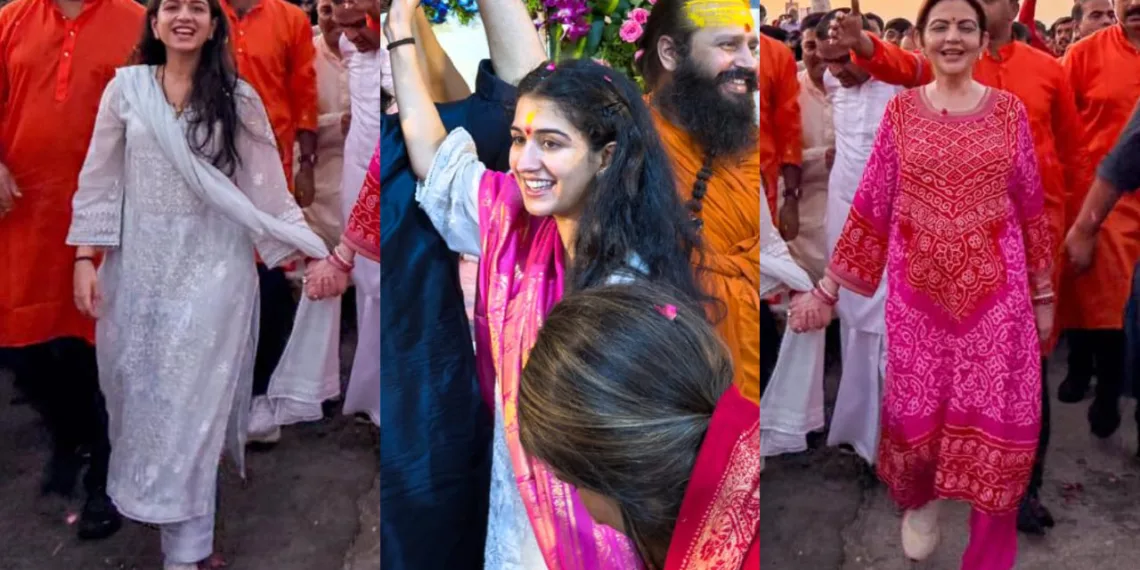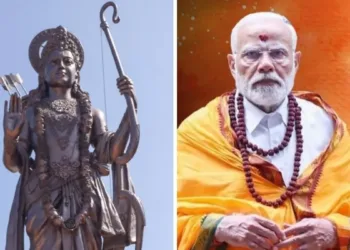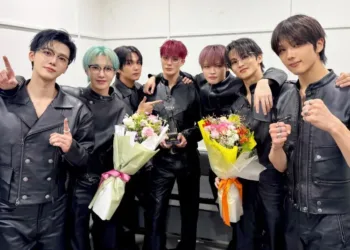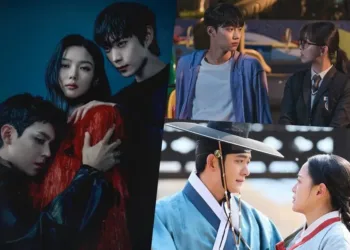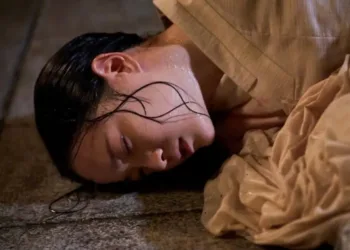When India’s most influential family celebrates a festival, their spiritual devotion often comes paired with thoughtful fashion choices that blend tradition with personal style. The recent Ram Navami celebrations in Dwarka presented a perfect example of this harmonious balance as Nita Ambani and her newly-wedded daughter-in-law Radhika Merchant graced the occasion in contrasting yet complementary traditional ensembles. Their appearance following Anant Ambani’s remarkable 170-kilometer padayatra from Jamnagar to Dwarka captured not just devotional fervor but also a masterclass in festive dressing that respects religious sentiments while maintaining individual expression.
The saas-bahu duo showcased their distinctive sartorial sensibilities—Nita embracing vibrant Gujarati heritage in a striking Bandhani creation while Radhika opted for understated elegance in pristine Chikankari—creating a visual harmony that perfectly encapsulated their evolving relationship. Beyond mere fashion statements, their coordinated yet distinctive choices reflected a deeper narrative about traditional values, familial bonds, and the graceful navigation of public life that has come to define the Ambani women’s approach to both spirituality and style.
Table of Contents
Radhika Ambani Elegant Simplicity: The Chikankari Choice
For the auspicious Ram Navami celebrations, Radhika Merchant demonstrated remarkable versatility in her style choices, pivoting dramatically from her recent high-fashion appearance at the Vivienne Westwood show at Mumbai’s Gateway of India. The newest Ambani family member embraced refined simplicity with a pristine white Chikankari kurta set that perfectly embodied the spiritual essence of the occasion while offering practical comfort for the warm April weather in Gujarat.
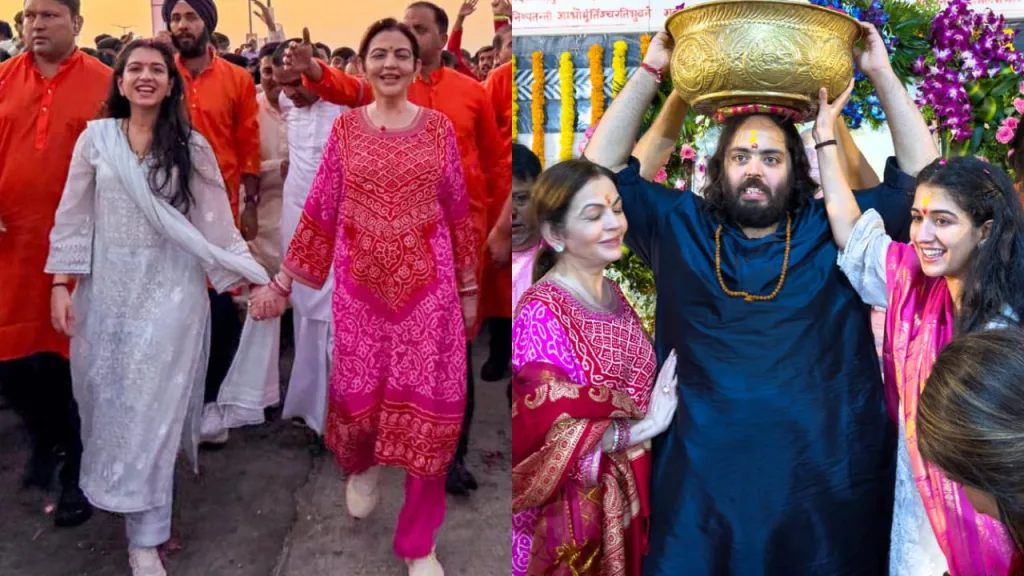
The traditional Chikankari ensemble featured the distinctive shadow-work embroidery technique originating from Lucknow, with delicate white-on-white threadwork creating subtle floral and geometric patterns across the fabric. This centuries-old craft, when executed on the finest cotton or mul material as in Radhika’s outfit, creates a garment that is not only visually elegant but also supremely breathable and lightweight—ideal qualities for navigating ceremonial proceedings in warm weather.
Radhika’s choice of white—symbolizing purity and serenity in Indian culture—aligned perfectly with the sacred nature of Ram Navami celebrations. The understated elegance of her outfit allowed her natural grace to shine through while demonstrating appropriate reverence for the religious significance of the day. Fashion historians might note that Chikankari work, with its Mughal influences blended with indigenous craftsmanship, represents the syncretic cultural heritage that defines much of Indian textile tradition.
In keeping with the occasion’s modesty, Radhika kept her accessories minimal yet meaningful. She wore simple diamond stud earrings that added a subtle sparkle without overwhelming the delicate embroidery of her outfit. Most significantly, she wore her mangalsutra—the sacred necklace that symbolizes her married status—prominently displayed, honoring tradition while embracing her new role in the Ambani family just months after her lavish wedding celebrations that captivated the nation.
Her hair was styled in a sleek, center-parted look, with loose waves flowing naturally—a contemporary touch that balanced the traditional elements of her ensemble. Radhika’s makeup remained minimal, featuring a fresh-faced approach with subtly defined eyes and a natural lip color that enhanced her youthful glow while respecting the religious context of the occasion.
Nita Ambani’s Vibrant Heritage: Celebrating Through Bandhani
While her daughter-in-law embraced serene minimalism, Nita Ambani chose to honor both religious tradition and her Gujarati cultural heritage through a vibrant Bandhani ensemble in festive hues. Her ombré suit transitioned beautifully through shades of deep red to bright pink—colors traditionally associated with auspiciousness, celebration, and divine feminine energy in Hindu iconography.
The Bandhani technique—one of India’s oldest tie-dye methods dating back over 5,000 years—featured prominently in her outfit, with distinctive white dots and patterns created through the intricate process of binding tiny portions of fabric before dyeing. This labor-intensive craft has deep cultural significance in Gujarat, often associated with celebrations and important life events, making it a particularly meaningful choice for the sacred occasion of Ram Navami.
Nita’s kurta was thoughtfully designed with a square U-neckline that framed her face elegantly while maintaining appropriate modesty for the religious setting. The flared sleeves added a graceful movement to her silhouette while providing practical comfort for the various ritual activities throughout the day. The vibrant color palette of her ensemble stood in beautiful contrast to Radhika’s pristine white, creating a visually compelling mother-daughter-in-law pairing that photographers couldn’t help but capture.
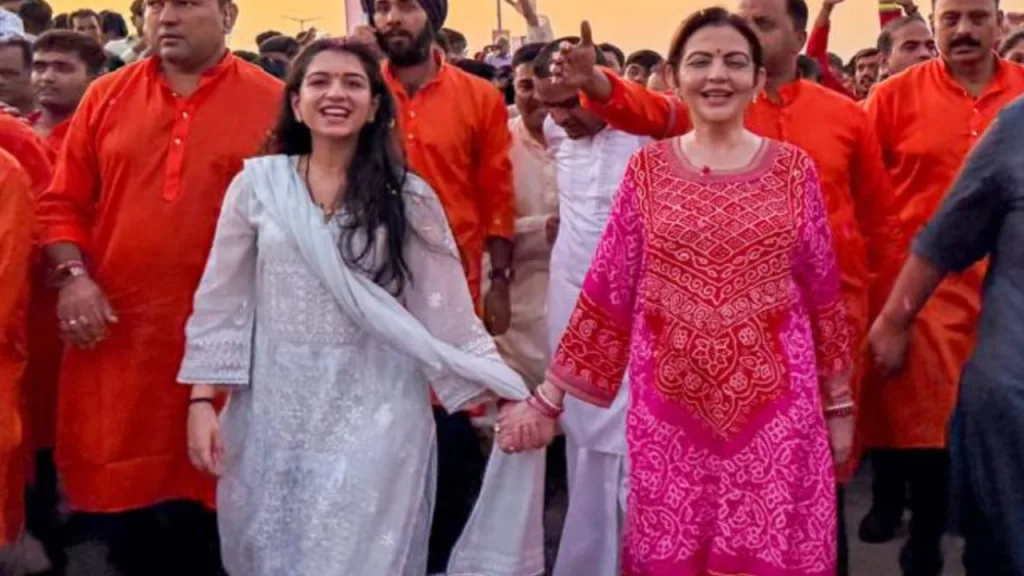
To complement her statement outfit, Nita chose traditional drop earrings featuring intricate metalwork and subtle stone embellishments. Her wrists were adorned with red bangles—traditional symbols of marital prosperity and well-being in Hindu culture. These thoughtful accessories enhanced the cultural authenticity of her look while adding visual interest to the overall ensemble.
Her makeup remained understated yet polished, with a focus on radiant skin and defined eyes that complemented rather than competed with her vibrant attire. Her hair was styled in a neat, elegant arrangement that maintained its composure throughout the day’s activities while framing her face beautifully.
| Feature | Radhika Merchant | Nita Ambani |
|---|---|---|
| Outfit Style | Chikankari kurta set | Bandhani ombré suit |
| Color Palette | Pure white | Red to pink ombré |
| Textile Technique | Fine shadow-work embroidery | Traditional tie-dye pattern |
| Neckline | Classic round | Square U-shape |
| Sleeve Style | Straight, traditional | Flared, flowing |
| Key Accessories | Diamond studs, mangalsutra | Drop earrings, red bangles |
| Cultural Origin | Lucknow, Uttar Pradesh | Gujarat |
| Symbolic Meaning | Purity, serenity | Auspiciousness, celebration |
| Footwear Choice | Practical sports shoes | Practical sports shoes |
| Ceremonial Addition | Red and pink shawl | Red and pink shawl |
Practical Elegance: Blending Tradition with Comfort
What made both Nita and Radhika’s fashion choices particularly noteworthy was their thoughtful balance of ceremonial elegance with practical considerations. In a refreshingly relatable twist, both women opted for comfortable sports shoes rather than traditional footwear—acknowledging the physical demands of ceremonial processions while prioritizing comfort over rigid adherence to conventional styling rules.
This practical choice reflected a modern sensibility that younger generations of traditional fashion enthusiasts might find particularly inspiring. By pairing their exquisite handcrafted ensembles with functional footwear, the Ambani women demonstrated that reverence for tradition need not come at the expense of personal comfort, especially during lengthy religious ceremonies.
The ceremonial proceedings culminated with both women being honored with draped shawls in vibrant red and pink hues—colors that harmonized beautifully with Nita’s outfit while creating a striking contrast against Radhika’s white ensemble. These ceremonial shawls, often presented as a mark of respect and blessing during religious functions, added an additional layer of cultural significance to their already thoughtful attire.
Throughout the event, photographers captured touching moments of the saas-bahu duo walking hand-in-hand—their contrasting outfits creating a visual representation of family unity expressed through individual style. These images of Nita and Radhika together embodied the essence of modern Indian family dynamics: respecting tradition while embracing individual expression, supporting one another while maintaining personal identity.
For fashion observers, this appearance offered a masterclass in context-appropriate dressing. Both women demonstrated an intuitive understanding that religious occasions call for different styling approaches than glamorous industry events—adapting their typically luxurious fashion sensibilities to embrace the more humble, devotional atmosphere of Ram Navami celebrations without sacrificing elegance or personal style.
Rashmika Mandanna Warrior Look in ‘The Girlfriend’ Birthday Poster Stuns Fans
Frequently Asked Questions
What is the significance of Bandhani and Chikankari textiles in Indian cultural celebrations?
Bandhani and Chikankari represent two of India’s most culturally significant textile traditions, each carrying deep historical and regional importance that makes them particularly meaningful choices for religious celebrations like Ram Navami. Bandhani, originating from Gujarat and Rajasthan over 5,000 years ago, is created through an intricate tie-dye process where fabric is pinched and bound at selected points before dyeing to create distinctive patterns.
Its name derives from the Sanskrit word “bandhan” meaning “to tie,” symbolizing the bonds of relationships and community—making Nita Ambani’s choice particularly meaningful for a family celebration. Beyond its aesthetic appeal, Bandhani carries auspicious connotations in Hindu tradition, with red and yellow variations traditionally worn during weddings and religious ceremonies as symbols of prosperity and spiritual protection.
Meanwhile, Chikankari, the delicate white-on-white embroidery technique chosen by Radhika Merchant, originated in Lucknow during the Mughal era. The word comes from the Persian “chikan” meaning “embroidery,” reflecting its historical development under the patronage of Mughal empress Nur Jehan. The technique features over 32 different stitches creating shadow-work, jaali (net), and relief patterns that symbolize refinement and cultural sophistication.
For religious occasions, Chikankari’s white palette represents purity and spiritual devotion, while its lightweight, breathable nature makes it practically suitable for lengthy ceremonial proceedings. By choosing these contrasting yet complementary textile traditions, Nita and Radhika not only honored India’s diverse craft heritage but also demonstrated how traditional textiles remain relevant expressions of both cultural identity and spiritual reverence in contemporary celebrations.
How does the Ambani family balance traditional values with their global lifestyle?
The Ambani family has developed a distinctive approach to balancing their traditional Indian values with their position as global business leaders and cultural influencers, visible not just in their Ram Navami celebrations but across various aspects of their public and private lives. At the core of their approach is maintaining deep connections to Hindu spiritual practices while engaging with international business and cultural spheres.
Religiously, they regularly participate in traditional ceremonies like this Ram Navami celebration, with Anant’s 170-kilometer padayatra (foot pilgrimage) demonstrating extraordinary personal commitment to spiritual traditions despite the family’s access to every modern convenience. Their homes reflect this balance through architecture that incorporates traditional Indian elements alongside contemporary design, particularly evident in their primary residence Antilia, which features a temple floor alongside high-tech amenities.
The family’s celebration of life milestones—from Isha’s wedding to Anant and Radhika’s recent nuptials—typically includes both traditional Hindu ceremonies and global entertainment elements, bringing together Vedic rituals with international performers. Their philanthropic work through the Reliance Foundation similarly bridges traditional values of seva (service) with modern approaches to social development.
Perhaps most visibly, their fashion choices—as demonstrated by Nita and Radhika during Ram Navami—showcase their ability to move fluidly between traditional Indian attire for cultural and religious occasions and international luxury brands for global business and social contexts. This conscious integration rather than compartmentalization of tradition and modernity has established the Ambanis as cultural ambassadors who demonstrate how Indian heritage can remain vital and relevant within a cosmopolitan global lifestyle.

